Abstract
Active oxygen species are generated during pathophysiologic conditions such as inflammation and ionizing radiation exposure. We tested the hypothesis that an early cellular event in response to these species involves regulation of ion channels. We exposed cells to gamma-irradiation or treated them with hydrogen peroxide, xanthine/xanthine oxidase, or [3H]thymidine and then monitored channel activity by the technique of whole-cell voltage clamping. Recordings showed that both normal and tumor cells exhibit an increase in K+ currents after treatment with radiation, H2O2, and xanthine/xanthine oxidase but not with high specific activity [3H]thymidine, suggesting that the signal for K+ channel activation originates at the cell membrane. A single noncytotoxic dose of 10 cGy induced measurable levels of K+ currents, suggesting that the induction of currents regulates biochemical changes in response to stress. To test whether channel activity is sensitive to active oxygen species, we pretreated cells with N-acetyl-L-cysteine (NAC) to increase cellular pools of free radical scavengers before radiation. In NAC-pretreated cells, K+ channel activation by gamma-irradiation was abolished. It has previously been shown that protein kinase C (PKC) is activated by ionizing radiation and can regulate K+ channels in some cells. However, the effect of radiation on induction of K+ channel activity was independent of PKC, since cells chronically exposed to phorbol esters still produced K+ currents after radiation. These results suggest that an early cellular response to oxidative stress is the activation of K+ channels.
Full text
PDF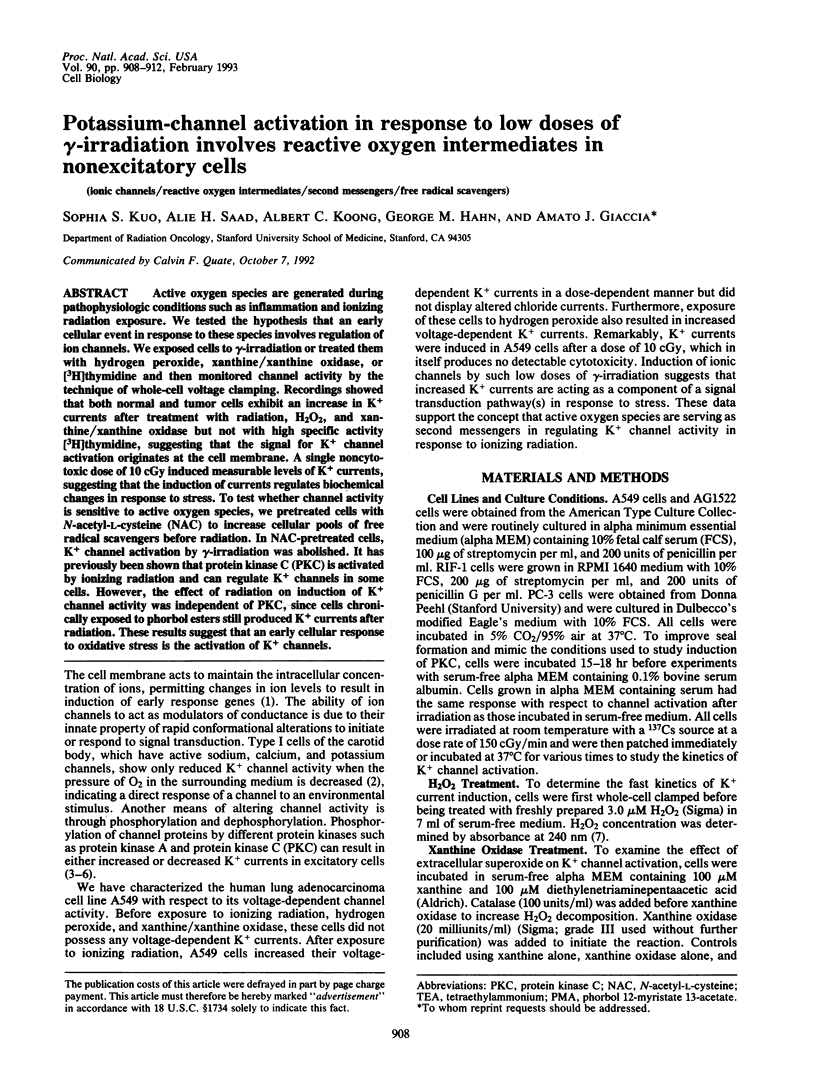
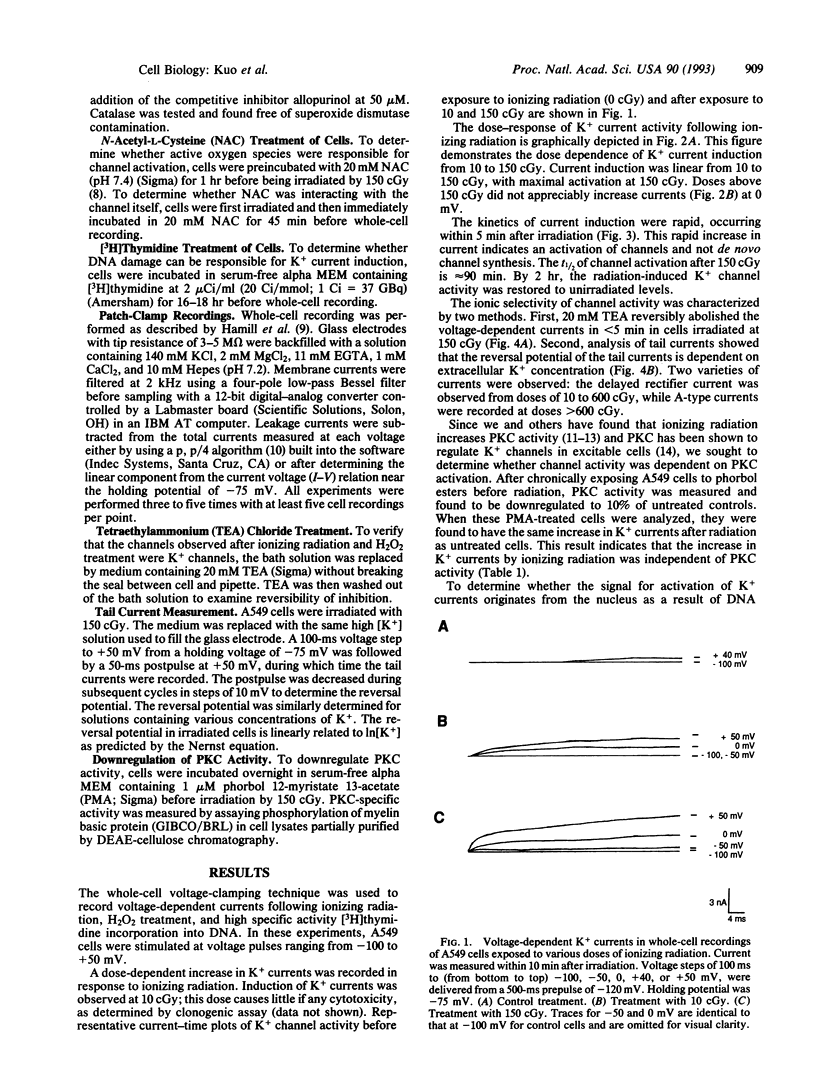
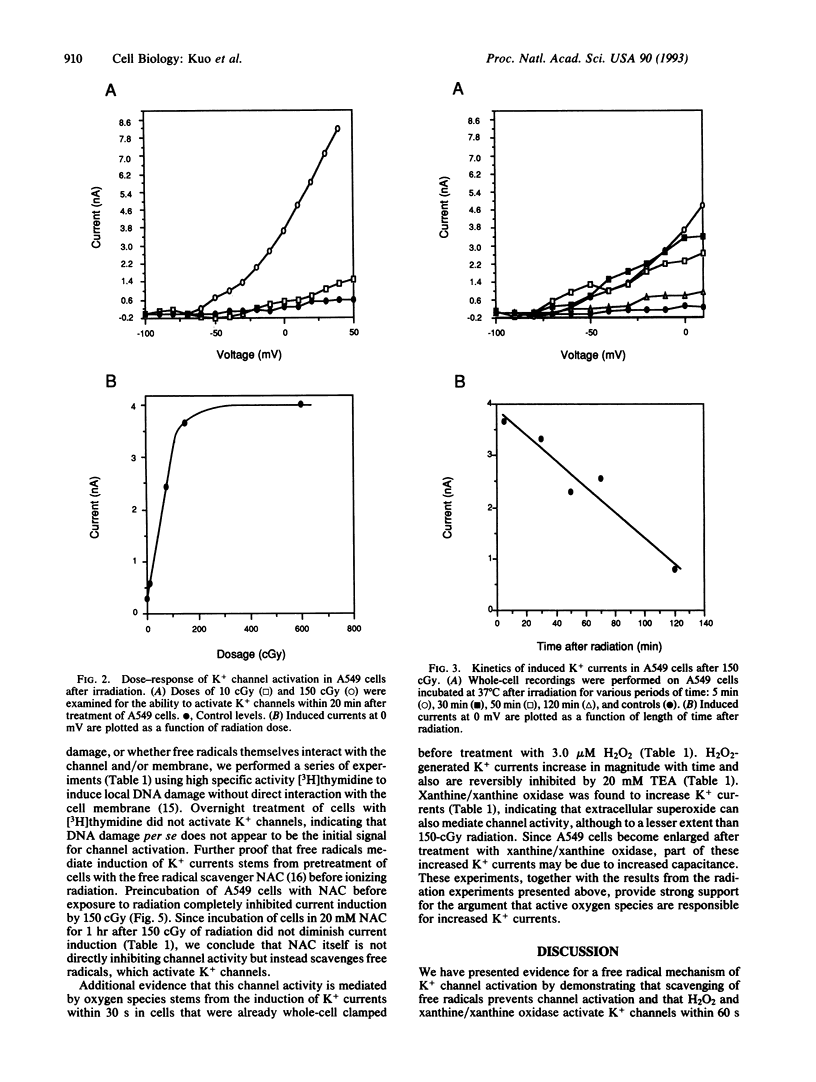
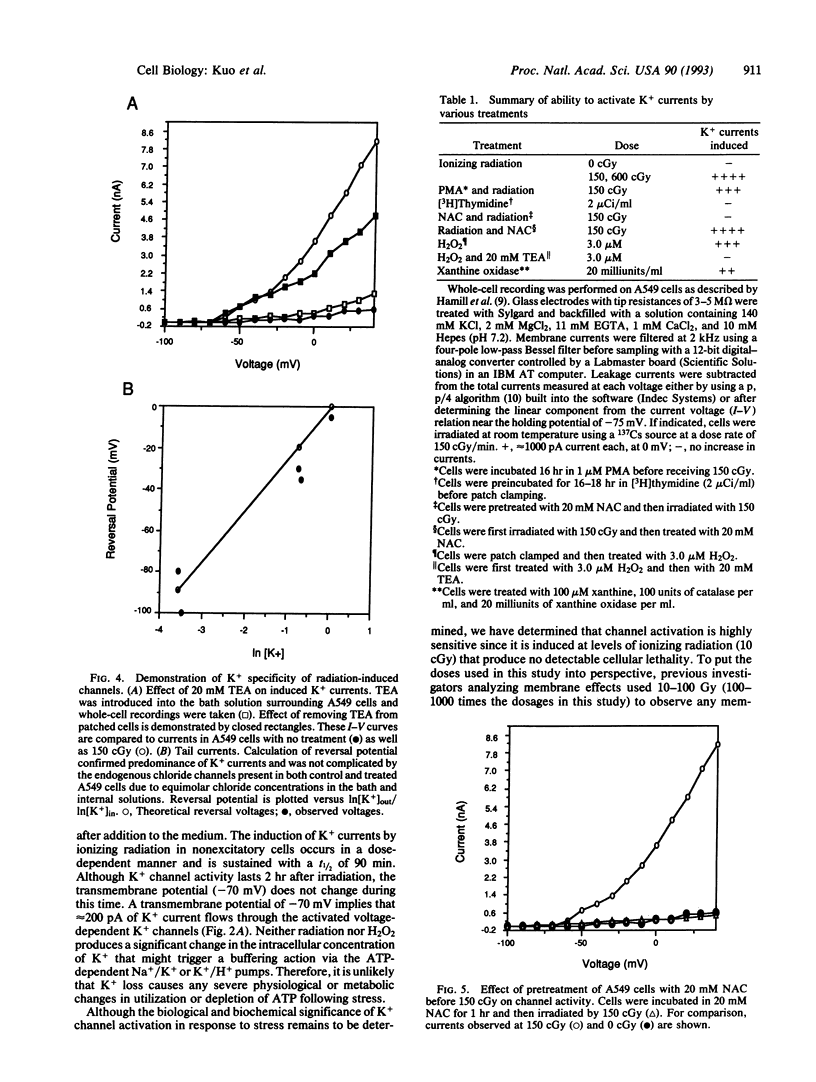
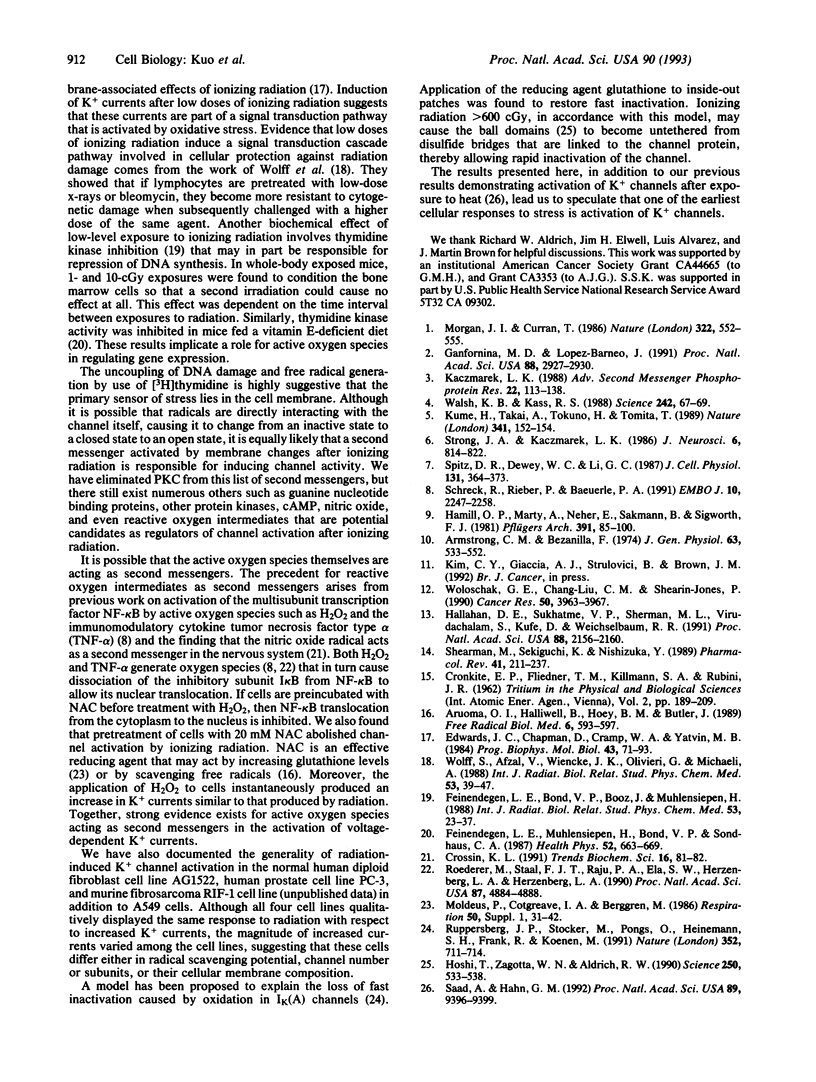
Selected References
These references are in PubMed. This may not be the complete list of references from this article.
- Armstrong C. M., Bezanilla F. Charge movement associated with the opening and closing of the activation gates of the Na channels. J Gen Physiol. 1974 May;63(5):533–552. doi: 10.1085/jgp.63.5.533. [DOI] [PMC free article] [PubMed] [Google Scholar]
- Aruoma O. I., Halliwell B., Hoey B. M., Butler J. The antioxidant action of N-acetylcysteine: its reaction with hydrogen peroxide, hydroxyl radical, superoxide, and hypochlorous acid. Free Radic Biol Med. 1989;6(6):593–597. doi: 10.1016/0891-5849(89)90066-x. [DOI] [PubMed] [Google Scholar]
- Crossin K. L. Nitric oxide (NO): a versatile second messenger in brain. Trends Biochem Sci. 1991 Mar;16(3):81–82. doi: 10.1016/0968-0004(91)90036-u. [DOI] [PubMed] [Google Scholar]
- Edwards J. C., Chapman D., Cramp W. A., Yatvin M. B. The effects of ionizing radiation on biomembrane structure and function. Prog Biophys Mol Biol. 1984;43(1):71–93. doi: 10.1016/0079-6107(84)90004-x. [DOI] [PubMed] [Google Scholar]
- Feinendegen L. E., Bond V. P., Booz J., Mühlensiepen H. Biochemical and cellular mechanisms of low-dose effects. Int J Radiat Biol Relat Stud Phys Chem Med. 1988 Jan;53(1):23–37. doi: 10.1080/09553008814550391. [DOI] [PubMed] [Google Scholar]
- Feinendegen L. E., Mühlensiepen H., Bond V. P., Sondhaus C. A. Intracellular stimulation of biochemical control mechanisms by low-dose, low-LET irradiation. Health Phys. 1987 May;52(5):663–669. doi: 10.1097/00004032-198705000-00020. [DOI] [PubMed] [Google Scholar]
- Ganfornina M. D., López-Barneo J. Single K+ channels in membrane patches of arterial chemoreceptor cells are modulated by O2 tension. Proc Natl Acad Sci U S A. 1991 Apr 1;88(7):2927–2930. doi: 10.1073/pnas.88.7.2927. [DOI] [PMC free article] [PubMed] [Google Scholar]
- Hallahan D. E., Sukhatme V. P., Sherman M. L., Virudachalam S., Kufe D., Weichselbaum R. R. Protein kinase C mediates x-ray inducibility of nuclear signal transducers EGR1 and JUN. Proc Natl Acad Sci U S A. 1991 Mar 15;88(6):2156–2160. doi: 10.1073/pnas.88.6.2156. [DOI] [PMC free article] [PubMed] [Google Scholar]
- Hamill O. P., Marty A., Neher E., Sakmann B., Sigworth F. J. Improved patch-clamp techniques for high-resolution current recording from cells and cell-free membrane patches. Pflugers Arch. 1981 Aug;391(2):85–100. doi: 10.1007/BF00656997. [DOI] [PubMed] [Google Scholar]
- Hoshi T., Zagotta W. N., Aldrich R. W. Biophysical and molecular mechanisms of Shaker potassium channel inactivation. Science. 1990 Oct 26;250(4980):533–538. doi: 10.1126/science.2122519. [DOI] [PubMed] [Google Scholar]
- Kaczmarek L. K. The regulation of neuronal calcium and potassium channels by protein phosphorylation. Adv Second Messenger Phosphoprotein Res. 1988;22:113–138. [PubMed] [Google Scholar]
- Kume H., Takai A., Tokuno H., Tomita T. Regulation of Ca2+-dependent K+-channel activity in tracheal myocytes by phosphorylation. Nature. 1989 Sep 14;341(6238):152–154. doi: 10.1038/341152a0. [DOI] [PubMed] [Google Scholar]
- Moldéus P., Cotgreave I. A., Berggren M. Lung protection by a thiol-containing antioxidant: N-acetylcysteine. Respiration. 1986;50 (Suppl 1):31–42. doi: 10.1159/000195086. [DOI] [PubMed] [Google Scholar]
- Morgan J. I., Curran T. Role of ion flux in the control of c-fos expression. Nature. 1986 Aug 7;322(6079):552–555. doi: 10.1038/322552a0. [DOI] [PubMed] [Google Scholar]
- Roederer M., Staal F. J., Raju P. A., Ela S. W., Herzenberg L. A., Herzenberg L. A. Cytokine-stimulated human immunodeficiency virus replication is inhibited by N-acetyl-L-cysteine. Proc Natl Acad Sci U S A. 1990 Jun;87(12):4884–4888. doi: 10.1073/pnas.87.12.4884. [DOI] [PMC free article] [PubMed] [Google Scholar]
- Ruppersberg J. P., Stocker M., Pongs O., Heinemann S. H., Frank R., Koenen M. Regulation of fast inactivation of cloned mammalian IK(A) channels by cysteine oxidation. Nature. 1991 Aug 22;352(6337):711–714. doi: 10.1038/352711a0. [DOI] [PubMed] [Google Scholar]
- Schreck R., Rieber P., Baeuerle P. A. Reactive oxygen intermediates as apparently widely used messengers in the activation of the NF-kappa B transcription factor and HIV-1. EMBO J. 1991 Aug;10(8):2247–2258. doi: 10.1002/j.1460-2075.1991.tb07761.x. [DOI] [PMC free article] [PubMed] [Google Scholar]
- Shearman M. S., Sekiguchi K., Nishizuka Y. Modulation of ion channel activity: a key function of the protein kinase C enzyme family. Pharmacol Rev. 1989 Jun;41(2):211–237. [PubMed] [Google Scholar]
- Spitz D. R., Dewey W. C., Li G. C. Hydrogen peroxide or heat shock induces resistance to hydrogen peroxide in Chinese hamster fibroblasts. J Cell Physiol. 1987 Jun;131(3):364–373. doi: 10.1002/jcp.1041310308. [DOI] [PubMed] [Google Scholar]
- Strong J. A., Kaczmarek L. K. Multiple components of delayed potassium current in peptidergic neurons of Aplysia: modulation by an activator of adenylate cyclase. J Neurosci. 1986 Mar;6(3):814–822. doi: 10.1523/JNEUROSCI.06-03-00814.1986. [DOI] [PMC free article] [PubMed] [Google Scholar]
- Walsh K. B., Kass R. S. Regulation of a heart potassium channel by protein kinase A and C. Science. 1988 Oct 7;242(4875):67–69. doi: 10.1126/science.2845575. [DOI] [PubMed] [Google Scholar]
- Wolff S., Afzal V., Wiencke J. K., Olivieri G., Michaeli A. Human lymphocytes exposed to low doses of ionizing radiations become refractory to high doses of radiation as well as to chemical mutagens that induce double-strand breaks in DNA. Int J Radiat Biol Relat Stud Phys Chem Med. 1988 Jan;53(1):39–47. doi: 10.1080/09553008814550401. [DOI] [PubMed] [Google Scholar]


